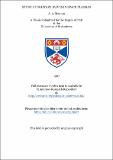Study of solitary waves in space plasmas
Abstract
Theoretical investigations have been made of arbitrary amplitude electrostatic solitary waves in non-thermal plasmas, which may be of relevance to ionospheric and magnetospheric plasmas, and dusty plasmas, which are most common in earth's and cometary environments as well as in planetary rings, for understanding the nonlinear features of localised electrostatic disturbances in such space plasma systems. This thesis starts with an introductory chapter where a very brief historical review of solitary waves in plasmas has been presented. The study of arbitrary amplitude electrostatic solitary waves in non-thermal plasma has considered a plasma system consisting of warm adiabatic ions and non- thermal electrons. It is found that a non-thermal electron distribution may change the nature of ion-acoustic solitary waves. If the ions are assumed to respond as a fluid to perturbations in the potential, with no significant trapping in a potential well, then a thermal plasma only supports solitary waves with a density peak. However, with a suitable distribution of non-thermal electrons, solitary waves with both density peaks and density depressions may exist. This study has also included a numerical analysis showing how these electrostatic solitary structures evolve with time. The investigation has then been extended to magnetised plasmas to study the effects of magnetic field on obliquely propagating electrostatic solitary structures. This attempt first employed the reductive perturbation method and investigated the nonlinear properties of small but finite amplitude obliquely propagating solitary waves in this magnetised non-thermal plasma model. This study is then generalised to arbitrary amplitude solitary waves by the numerical solution of the full nonlinear system of equations. This numerical method has also been utilised to present a similar study in another popular plasma model, namely the two-electron-temperature plasma model. The study of arbitrary amplitude solitary waves in a dusty plasma has considered another plasma system which consists of an inertial dust fluid and ions with Maxwellian distribution and has investigated the nonlinear properties of dust- acoustic solitary waves. A numerical study has also been made to show how these dust-acoustic solitary waves evolve with time. The effects of non-thermal and vortex-like ion distributions are then incorporated into this study. The study of arbitrary amplitude electrostatic solitary waves in this thesis has finally been concluded with some brief discussion of our results and proposal for further studies, which are expected to generalise and develop our present work to some other extents, in this versatile area of research.
Type
Thesis, PhD Doctor of Philosophy
Collections
Items in the St Andrews Research Repository are protected by copyright, with all rights reserved, unless otherwise indicated.

